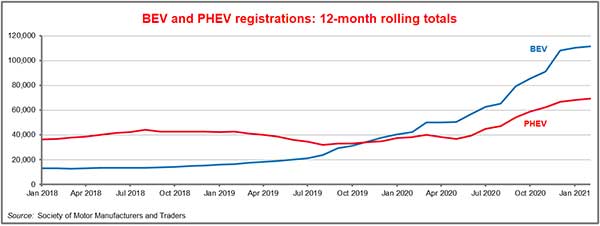What are we talking about when we talk about electric vehicles (EVs)? We mostly refer to two types of vehicle: battery electric vehicles (BEVs) and plug-in hybrid electric vehicles (PHEVs). Here’s what you need to know about both:
BEVs
A BEV is often referred to as a ‘pure electric vehicle’ as they are powered entirely by electricity, meaning a BEV has no internal combustion engine (ICE), no fuel tank and no exhaust pipe. Instead, it has one or more electric motors powered by a large on-board battery.
As a result, BEVs emit zero tailpipe emissions making them greener, cleaner and better for the environment than petrol or diesel cars.
Classed as "zero-emissions vehicles", BEV drivers are entitled to a range of money saving incentives.
PHEVs
A PHEV has both an electric battery and an ICE. Unlike other hybrids which charge their batteries via regenerative braking, a PHEV battery is primarily charged by plugging it into the electricity grid. The PHEV can then run entirely on the electric battery, entirely on the ICE, or by using a combination of both, thus resulting in greater driving ranges between being refilled or recharged.
But this fuel-flexibility comes at a cost. While PHEVs are typically considered cleaner than traditional cars, their reliance on fossil fuels also means they are less environmentally friendly than BEVs. For example, a popular model of PHEV, the BMW 3 Series, can travel about 40 miles (depending on driving conditions) powered just by electricity – which means 40 miles without any tailpipe emissions – before it needs to be charged again. But when running the ICE, it produces about 39g CO2/km on average.
Registrations of BEVs and PHEVs
There’s no doubt that both BEVs and PHEVs have become increasingly popular in recent years. The annual total number of BEV registrations has risen by almost 700% over the past three years, and by 90% for PHEVs.

During that time, there has been an eye-catching shift; more BEVs have started selling than PHEVs, likely due to the environmental and cost saving benefits of BEVs.
What’s more, the growth of BEVs and PHEVs is in sharp contrast to the decline of petrol and diesel cars. The number of annual petrol registrations has fallen by a third over the past three years and the number of diesel registrations has fallen by three quarters.
Of course, both diesel and petrol engines still account for most of the marketplace. But this is continually changing and is likely to gain further momentum now that the Government has announced the end of new petrol and diesel sales by 2030.
Costs and Savings of BEVs and PHEVs
When considering what vehicles to incorporate into a fleet, we encourage our customers to focus on a total cost of ownership - (TCO) framework – that is, the money spent over a vehicle’s full working life. When overall cost is considered from a TCO perspective, both BEVs and PHEVs can make a lot of sense for fleets.
Of course, buying a BEV or PHEV means higher ‘sticker prices’ than their fossil-fuelled counterparts.
To assist with this higher ‘sticker price’ there are various Government grants available to encourage electric motoring. The primary one is the Plug-In Car Grant, which takes 35% off the cost of certain new electric vehicles – up to a maximum of £2,500. It applies to both BEVs and PHEVs, provided that:
- They cost less than £25,000.
- They have CO2 emissions of less than 50 grams per kilometre (g/km).
- They can travel at least 70 miles without any emissions.
A full list of eligible vehicles is available here.
And there are also grants available for installing charge points at home or at work. These include:
- The Electric Vehicle Homecharge Scheme (EVHS). This offsets 75% of the cost of installing a charge point at home, up to a maximum of £350 (including VAT).
- The Workplace Charging Scheme (WCS). Offers vouchers worth £350 for each of the first 40 charge points installed by an employer.
- 100% First-Year Allowance (FYA). This applies for businesses installing charge points, and is currently scheduled to continue until 2023.
Out on the road is where the cost savings can be seen. Think about the cost of fuel, for example; electricity is much cheaper than either petrol or diesel.
According to EDF Energy, the average cost to travel 100 miles on electricity is about £4, compared to about £9 for petrol. What’s more, some locations offer free charging, resulting in even greater cost savings.
Because they are fully electric, BEVs will benefit from higher savings than PHEVs, however PHEVs will still benefit from the electric part of their fuel mix.
But the savings aren’t restricted to charging, and fuel. BEVs and PHEVs are also on the right side of various measures being introduced by local politicians around the country. For example, there is a ‘cleaner vehicle discount’ in London – which currently means that vehicles emitting less than 75g/km and with a minimum zero-emissions range of 20 miles are exempt from the city’s Congestion Charge. (As of 25 October 2021, this discount will only apply to BEVs.) BEVs and PHEVs will continue to avoid additional costs incurred from the ever increasing number of Clean Air Zones throughout the UK.
Other considerations
Range Anxiety
There are two main reasons why ‘range anxiety’ – concern around a BEV’s driving range – is quickly becoming a thing of the past.
The first is the improved (and constantly improving) battery technology in electric cars. A real-world range of 150 to 200 miles is now pretty standard, while some new models of electric vehicle – such as the Tesla Model 3 Long-Range – can go beyond 300 miles. This is more than enough for most purposes, particularly given that the average car journey is about 8 miles long.
The second reason is the growth of the public charging network. As of September 2021, the UK’s public charging network currently consists of about 26,000 charge points, with a total of over 41,000 connectors in over 16,000 locations on the national road network; a 270% increase over the past five years. What’s more, 4,500 of these charge points are either rapid or ultra-rapid chargers, able to charge a car by 80% in 25 to 40 minutes, or faster. And there’s a lot more charge points expected in coming years.
That said, there are some areas – i.e. rural areas such as the Scottish Highlands – where charge points are in shorter supply. Drivers who make frequent long trips, either in these or other remote areas, may feel more confident having the back-up of a petrol engine in a PHEV. A typical PHEV can travel about 30 miles on pure electric, but might add another 300 miles on petrol – so there’s almost always the option of filling up at a petrol station.
Maintenance & Repair
It’s long been suggested that, because they literally have fewer moving parts, electric vehicles face lower maintenance and repair bills than their ICE equivalents. On the same principle, you might also think that BEVs, which are entirely electric, face lower bills still than PHEVs, which retain some ICE components.
In fact, a recent study found that the lifetime maintenance and repair bills for BEVs are PHEVs are practically identical – and they’re both around half the maintenance cost for ICE vehicles.
BEV v PHEV - Which is best for your fleet?
There is no one-size-fits-all approach. Different fleets and different drivers will have different requirements.
However, there are some general principles that are worth sticking to when considering adding BEVs and PHEVs to your fleet.
The first is to consider your organisation’s needs. Do you have specific carbon targets? Or participate in energy assessment schemes? If so, the difference between zero-emission BEVs and low-emission PHEVs could be crucial.
Then there are your driver’s needs. Do they, or could they easily access charge points, perhaps at home or work? If so, then either a BEV or PHEV could be right for them. Do they only have to make relatively short journeys? That might strengthen the case for a BEV. Will they be making long journeys through rural areas? Then a PHEV may be the best option.
And, remember, drivers should be included in the process. A driver suitability survey can help you identify which drivers are ready to adopt EVs, who may not be currently suitable, and those who, with a little training or support, could eventually adopt. Some might also be concerned about making the leap from an ICE to an all-electric vehicle and may need training. ALD Electric helps make the transition to EVs as smooth as possible. Working with you and your drivers, we can identify challenges so you can address and overcome them prior to a large-scale roll out of EVs into your fleet. Together, we will select the products and services you need, choosing as many or as few as necessary to address your particular mobility requirements. Let us help you shape the future of your fleet.
For more information about ALD Electric, please contact us at roadtozero@aldautomotive.com
About the contributor

Tash Turner
Fleet Consultant
Specialisms: Financial modelling, Total Cost of Ownership, Fleet Optimisation and Mobility
Tash has over 12 years’ industry experience, including previous roles in Strategic Account Management at KINTO UK and Venson Automotive, working with a variety of private, public and not for profit businesses with both car and van fleets varying from 50 – 5,000 vehicles.
Tash joined ALD in 2021, bringing a wealth of experience and proven ability in working in partnership with customers to identify cost-saving opportunities, share best practice and advise on future strategic fleet decisions. She has considerable experience working with businesses to identify the most suitable funding methodologies as well as enabling and supporting the creation of robust, adaptable and suitable fleet polices, including integration of alternative fuels and Total Cost of Ownership (TCO).
Email: tash.turner@aldautomotive.com